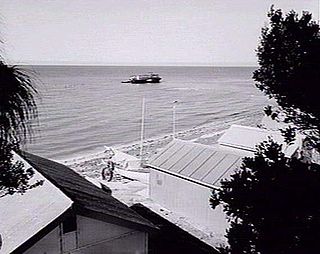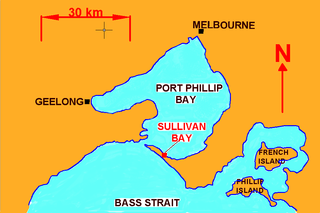
George Bass was a British naval surgeon and explorer of Australia.
The history of Tasmania begins at the end of the most recent ice age when it is believed that the island was joined to the Australian mainland. Little is known of the human history of the island until the British colonisation in the 19th century.

Risdon Cove is located on the east bank of the Derwent River, approximately 7 kilometres (4 mi) north of Hobart, Tasmania. It was the site of the first British settlement in Van Diemen's Land, now Tasmania, the smallest Australian state. The cove was named by John Hayes, who mapped the river in the ship Duke of Clarence in 1794, after his second officer William Bellamy Risdon.

Flinders Island, the largest island in the Furneaux Group, is a 1,367-square-kilometre (528 sq mi) island located in the Bass Strait, northeast of the island of Tasmania. Flinders Island is part of the state of Tasmania, Australia, and is situated 54 kilometres (34 mi) from Cape Portland and it is located on 40° south, a zone known as the Roaring Forties.

The Colony of New South Wales was a colony of the British Empire from 1788 to 1900, when it became a State of the Commonwealth of Australia. At its greatest extent, the colony of New South Wales included the present-day Australian states of New South Wales, Queensland, Victoria, Tasmania, and South Australia, the Northern Territory as well as New Zealand. The first "responsible" self-government of New South Wales was formed on 6 June 1856 with Sir Stuart Alexander Donaldson appointed by Governor Sir William Denison as its first Colonial Secretary.

John Pascoe Fawkner was an early Australian pioneer, businessman and politician of Melbourne, Australia. In 1835 he financed a party of free settlers from Van Diemen's Land, to sail to the mainland in his ship, Enterprize. Fawkner's party sailed to Port Phillip and up the Yarra River to found a settlement which became the city of Melbourne.

Indented Head is a small coastal township located on the Bellarine Peninsula, east of Geelong, in the Australian state of Victoria. The town lies on the coast of the Port Phillip bay between the towns of Portarlington and St Leonards.

The topsail schooner, Enterprize, was built in Hobart, Tasmania in 1830 by William Pender. It was used for coastal transport of cargo such as coal, livestock, and supplies.

His Majesty's Armed Survey Vessel Lady Nelson was commissioned in 1799 to survey the coast of Australia. At the time large parts of the Australian coast were unmapped and Britain had claimed only part of the continent. The British Government were concerned that, in the event of settlers of another European power becoming established in Australia, any future conflict in Europe would lead to a widening of the conflict into the southern hemisphere to the detriment of the trade that Britain sought to develop. It was against this background that Lady Nelson was chosen to survey and establish sovereignty over strategic parts of the continent.
The history of Australia from 1788–1850 covers the early colonial period of Australia's history, from the arrival in 1788 of the First Fleet of British ships at Sydney, New South Wales, who established the penal colony, the scientific exploration of the continent and later, establishment of other Australian colonies.

The city of Melbourne was founded in 1835. The exact circumstances of the foundation of Melbourne, and the question of who should take credit, have long been matters of dispute.

Between 1788 and 1868, about 162,000 convicts were transported from Britain to various penal colonies in Australia.

Sullivan Bay lies 60 km due south of Melbourne on Port Phillip, one kilometre east of Sorrento, Victoria. It was established as a short-lived convict settlement in 1803 by Lieutenant-Colonel David Collins, who named the bay after the Under-Secretary of State for War and the Colonies, John Sullivan.

Captain Matthew Flinders was an English navigator and cartographer who led the second circumnavigation of New Holland that he would subsequently call "Australia or Terra Australis" and identified it as a continent. Abel Tasman had circumnavigated it more widely in 1642-43 and had charted its north coast in 1644.
The Baudin expedition of 1800 to 1803 was a French expedition to map the coast of New Holland. Nicolas Baudin was selected as leader in October 1800. The expedition started with two ships, Géographe, captained by Baudin, and Naturaliste captained by Jacques Hamelin, and was accompanied by nine zoologists and botanists, including Jean-Baptiste Leschenault de la Tour, François Péron and Charles-Alexandre Lesueur as well as the geographer Pierre Faure.
Leonard Fosbrook was an early settler in Tasmania, Australia.














